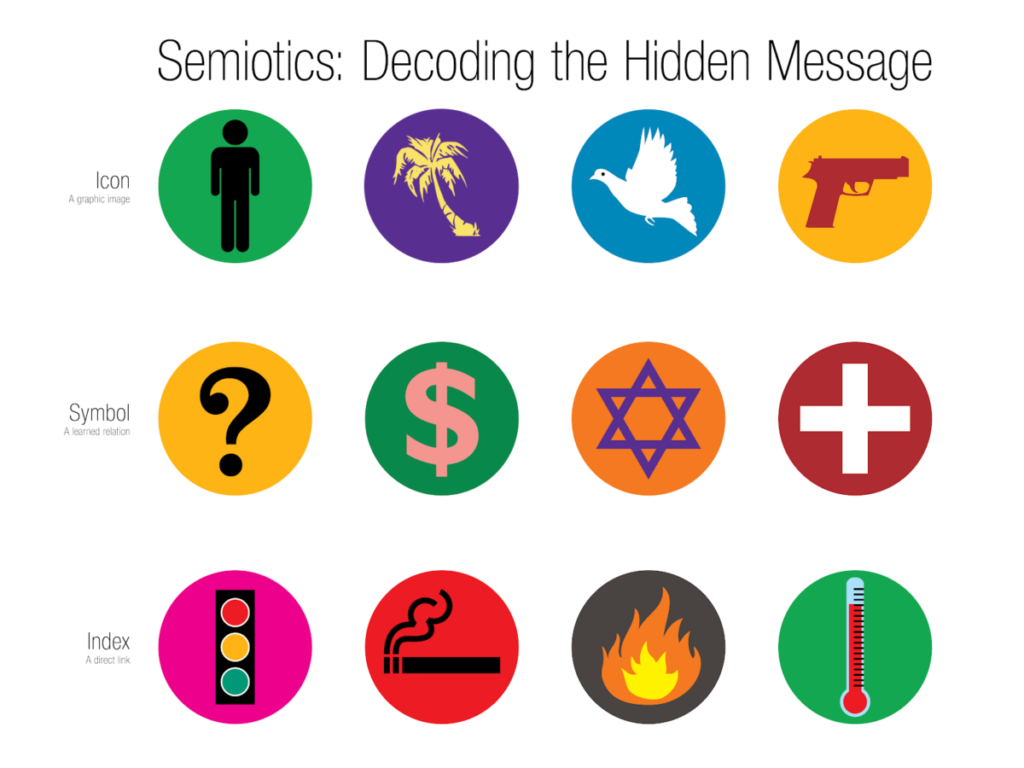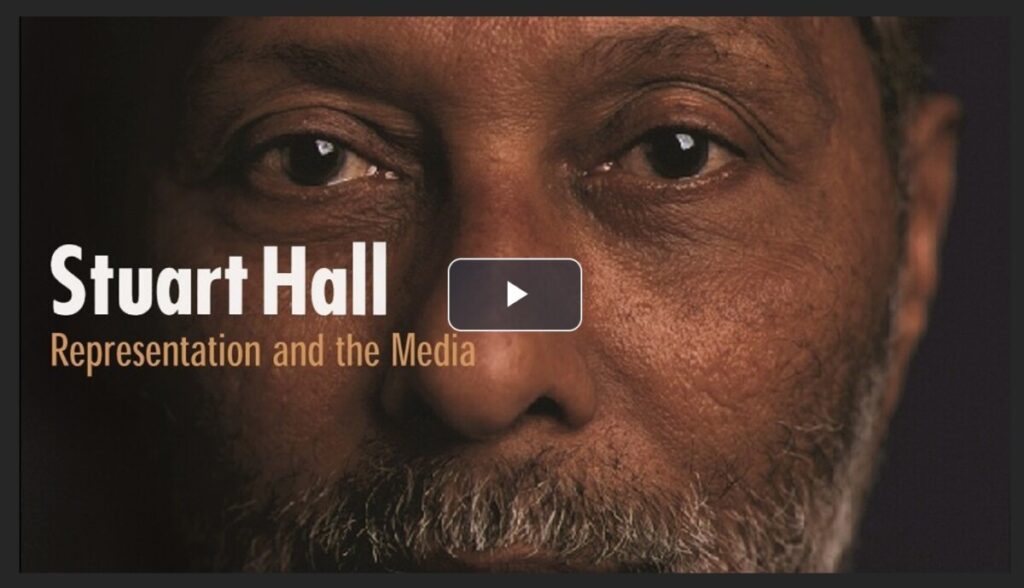Tasks Due Last Week
- Research Journal
- The Medium is the Message
- Discussion: Week 9
- Reading Response 8
- Week 9 Agenda Checklist
This Week’s Topics
- Check-in
- Feedback
- Research Project Meetings
- Representation and Context
- Stereotype in Advertising Media
- Research Paper 2
- Week 10 Agenda Checklist
Check-in
Hello all. I hope you had a good week. I can’t believe we are on Week 10 with only have five classes left!
I hope you enjoyed the main focus of last week’s class, the Media is the Message and were able to learn about how the design of persuasive social media “massages” us and how that change/manipulation has lasting effects on society. As current consumers and future design leaders, your opinion and actions matter. Looking at the Discussion this week, I observed thoughtful proposed solutions and insightful responses. Keep up the great work!
The topics we will be covering this week will build on our reading of Roland Barthes’ essay “Rhetoric of the Image.” We will explore representation, context, and the use of rhetoric in advertising, specifically concerning the perpetuation of ethnic and gender biases. The work we engage in today will inform your second and last research paper and hopefully also your Research Project/Presentation.
Please be in touch if any questions or concerns: jspevack@citytech.cuny.edu.
Feedback & Revisions
Feedback and grades for Week 8 assignments have been added to your post as a comment and in Hypothesis. Grades have also been added to the Gradebook.
I know that we are often driven by reward, ie: grades, but please note that it’s more important to me to provide thoughtful feedback on your responses to help you grasp the concepts rather than focus just on the grades. This is why I encourage you to revise, revise, revise. Of course, that creates extra work for me (and you), but I think it’s worth it. It takes me about 8-12 hours to review all the Reading Response posts submitted each week, so please know that any late submissions or revisions might take me a little while to get through. If there are any revisions that you’d like feedback on right away, send me a note, and I’ll try to prioritize those.
Don’t forget to submit your Weekly Agenda Checklist, indicating the tasks you’ve completed. This is required.
Research Project Meetings
Contact me this week to schedule a time to discuss your Research Project ideas: jspevack@citytech.cuny.edu
Activities
Below find the information covered in this session. Complete all of the following activities, videos, and assignments.
1. Representation and Context (90+ minutes)
Last week we examined Marshall McLuhan’s ideas about media. We learned that the medium is integral to the message and how we receive it. This week we will look at representation and context by exploring the use of stereotypes in media (print, radio, television, and online advertisements). In your second Research Paper, you will use the terminology and approaches that we cover this week to deconstruct a historical or contemporary advertisement that uses coded cultural message(s) of racial, ethnic, and/or gender stereotypes.
We will return to Saussure (sign, signifier, signified) and Peirce (symbol, icon, index) to refresh our understanding of early semiotics. We will incorporate the terms we learned in the last reading of Barthes (connoted, denoted, iconic messages, linguistic messages) and explore additional terms such as encoding, decoding, polysemic, myth, and naturalization. Lastly, we will look at Jamaican-born cultural studies scholar and activist Stuart Hall who explored how the dynamics of media representation reinforce societal power structures.
Terminology
Before we go any further, let’s make sure we all understand the semiotic terms we will need to deconstruct an advertisement.
Ferdinand de Saussure
- Sign: A sign is anything that creates meaning composed of a signifier and a signified.
- Signifier: A word, an image, a sound, anything we see, speak or hear to refer to the sign.
- Signified: The concept that our mind conjures in relation to the sign.
Charles Sanders Peirce
- Icon: signifier resembles the signified
- Symbol: arbitrary learned relationship between the signifier and signified
- Index: signifier is caused by or linked to the signified
Here’s a graphic to clarify these terms:

Roland Barthes
Building on Saussure and Peirce, Barthes argued that when we construct a sign (encoding), its reception (decoding) does not take place in a vacuum. Our individual experience, society, and culture impact its meaning and how it is interpreted. In our reading last week, we looked at Barthes’ close-reading of the Panzani advertisement. Take a look at this breakdown of “Rhetoric of the Image” by Lesley Lanir where he covers some of the following terms.
- Encoding: creating a message for transmission (i.e., creation and distribution of an advertisement)
- Decoding: the process of interpreting a message (i.e., watching and interpreting an advertisement)
- Connotation: symbolic or cultural meaning (a coded message)
- Denotation: Literal meaning (a message without code)
- Linguistic message: words used to convey meaning
- Non-coded iconic message: an image with literal meaning
- Coded iconic message: an image with a coded message
- Polysemic: a sign that has multiple meanings
- Myth: a widely accepted meaning of a sign
- Naturalization: in a society, the repeated use of signs shapes its meaning
Here’s a 9+ minute video that takes us through some of these semiotic terms from a film perspective. Advertising takes a similar approach.
Stuart Hall
Stuart Hall was a Jamaican-born British sociologist, cultural theorist and political activist. He looked at the power of mainstream media (advertising, TV, film, etc) to understand the representation of race, gender, class, ethnicity, and religion. Here are some of the theories and terms associated with his work.
- Reception Theory: This theory asserts that advertising and media are encoded and decoded. The creator encodes messages and values into media which are then decoded by the audience. Audiences will decode the media in different ways and not always in the way the creator intended.
- Dominant, or Preferred Reading: how the creator wants the audience to view the advertisment or media.
- Oppositional Reading: when the audience rejects the preferred reading, and creates their own meaning. This can happen when content is controversial or when the audience holds different beliefs or is of a different age or culture.
- Negotiated Reading: a compromise between the dominant and oppositional readings. The audience accepts some of the creator’s view, but also has their own views.
- Representation Theory: There is not a true representation of people or events in media. Designers/creators try to ‘fix’ a ‘preferred meaning’ through ideology or stereotyping. Historically, this is driven by people in power.
This 6+ minute video explains Hall’s Reception Theory:
This 3-minute video breaks down Hall’s Representation Theory:
This 7-minute video gives a bit more detail and context to Hall’s Representation Theory:
In this 55 minute documentary from 1997, Stuart Hall offers an extended meditation on representation. Take a close look at 36:00 he speaks about representation in advertising. Note that this video was created is prior to social media and the internet era that we live in now. Consider if the power structure has changed and why/why not? Make sure you are logged into CUNY SSO (single sign-on) to view.

2. Stereotype in Advertising Media (1+ hours)
The use of stereotypes to communicate meaning and sell products has a long history in advertising media and visual communications.
As we observed in our readings on the lack of diversity in design, leadership in the field of advertising media and design was (and still is) dominated by white, heterosexual men. And as we see from our recent study of media and the message, and representation above, mainstream media is a powerful force for intentionally or unintentionally reinforcing biases in society. It’s changing, but women and BIPOC designers in advertising are historically limited. That lack of diversity in creative leadership has allowed widely-held biases to continue to flourish.
Here are some sources to get you started in your research for Research Paper 2. If you have already chosen a historical 19th or 20th-century print advertisement that uses obvious and/or documented racial, ethnic, or gender stereotypes to sell the product, review the sources below to support your research. If you haven’t yet chosen an advertisement, browse the references below to find some.
History of racial, gender, ethnic, cultural stereotypes in advertisements
- Race and Ethnicity in Advertising
- African Americans and Advertising – Marya McQuirter, Digital Curator
- Chinese Americans and Japanese Americans in Advertising :: Full Essay PDF
- Cultural Transformation and Chinese Figures in Nineteenth Century American Trade Cards – Lenore Metrick-Chen, Drake University
- European Americans and Advertising
- Jews and American Advertising – Eli Diner, University of California, Los Angeles, and Hasia Diner, New York University
- Latinos and Advertising – James Rodriguez, New York University
- Native Americans and Advertising – Stephanie A.L. Molholt, Community College of Baltimore County
- Sexuality, Race and Ethnicity in Advertising :: Full Essay PDF
- South Asian Americans in Advertising :: Full Essay PDF
- T. Burns Collection of Racial Stereotypes, 1880s-1983
- Timeline: Race and advertising in America
- ‘Ethnicity is authenticity’: how America got addicted to racist branding
- Blackface and the Birth of the American Stereotype
- The Racism of 19th Century Advertisements
- The Real and Problematic History Behind Aunt Jemima
- “Ethnic Notions: African American Stereotypes and Prejudice” (Documentary 1987)
- Gender stereotypes have been banned from British ads (some historical ads and context here)
- Gender Advertisements (1979 book by the sociologist Erving Goffman with analysis of hundreds of US ads for gender roles)
- Food Is Love : Advertising and Gender Roles in Modern America, Parkin, Katherine J., 2007. ProQuest Ebook Central, (Book. Use your Library Card to access)
- Gender roles in 1940’s Ads (examples from cinema advertisements)
3. Assignment: Research Paper (3+ Hours)
Follow the assignment guidelines and prompts for Research Paper 2 – DUE Sunday, November 14th, at 11:59 pm
Working off of your reading response and research from last week on Roland Barthes’ 1977 essay, “Rhetoric of the Image,” select a historical 19th or 20th-century advertisement that uses obvious and/or documented racial, ethnic, or gender stereotypes to sell the product.
In your paper, you’ll critically examine and deconstruct your historical advertising image in a manner similar to Barthes’ approach and include references to Saussure, Peirce, and Hall’s theories covered in today’s agenda.
Refer to Assignment: Research Paper 2 for guidelines.
Resources
Week 10 Agenda Checklist
Below are all of the tasks, big and small, for this week. The deadline is Sunday, November 14th, at 11:59 pm. Successful and timely completion of these tasks will contribute to your grade. Submit your Weekly Agenda Checklist, indicating the tasks you’ve completed. This is required.
If you have any questions, don’t hesitate to reach out: jspevack@citytech.cuny.edu




Recent Comments